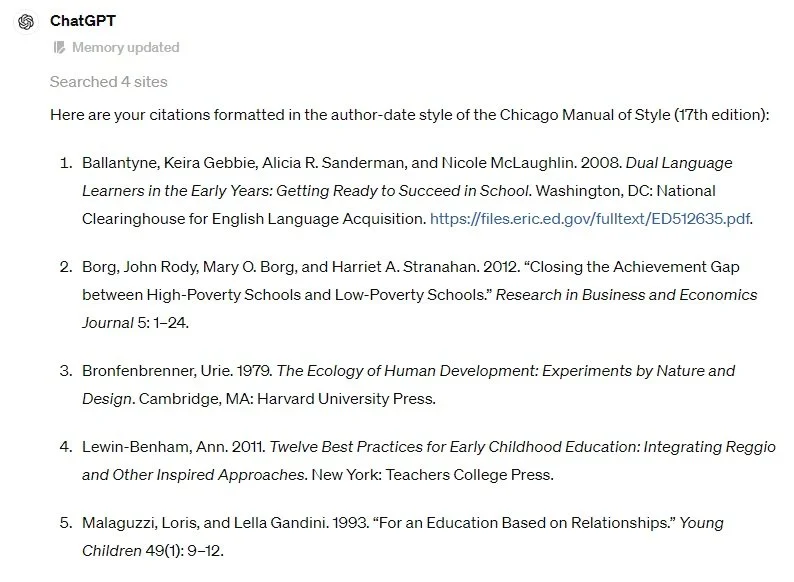ChatGPT 4o
On May 13, 2024, OpenAI released its latest iteration of ChatGPT: ChatGPT 4o (the o stands for omni). This version is an improved model of ChatGPT-4, which was only available to paid subscribers. ChatGPT 4o supports more than 50 languages. (See OpenAI’s website for the latest information on ChatGPT 4o.) Perhaps most importantly, it is available for everyone—you don’t have to pay.
ChatGPT’s Evolution
Before exploring ChatGPT 4o’s capabilities, let's review the evolution of ChatGPT and how the different versions could (and can) be used as an editing tool:
ChatGPT 3.5
ChatGPT 3.5, now replaced by ChatGPT 4o, was available to everyone and could:
Correct basic grammar errors (e.g., changing “He go to the store” to “He goes to the store”)
Provide general fact-checking (e.g., summarizing the plot of a well-known novel)
Generate brainstorming ideas (e.g., suggesting generic titles for a blog post)
ChatGPT 4
Available only to paid subscribers (until this week), ChatGPT-4 introduced:
Advanced stylistic improvements (e.g., transforming “The book is interesting and well-written” to “The book captivates with its engaging narrative and eloquent prose”)
Internet fact-checking (e.g., identifying authors and publication dates accurately)
Polished content production (e.g., writing engaging article introductions)
Collaborative feedback (e.g., offering detailed suggestions on improving the logical flow in a research paper)
ChatGPT 4o
ChatGPT 4o, free for all users as of May 13, includes an enhanced version of ChatGPT-4 and offers the following:
Improved context understanding (e.g., following the structure of a manuscript)
More accurate responses (e.g., providing precise grammar corrections)
Better handling of complex queries (e.g., suggesting nuanced stylistic edits)
Testing It Out
I tried ChatGPT 4o on one of my earlier AI tests: formatting reference lists. (See my earlier blog post “AI & References: A New Era” for my original test.) Here’s what I asked:
ChatGPT 4o handled it like a pro on the first try:
Impressive! The citations were nearly perfect, with only a minor spacing error in the last entry. Note that ChatGPT 4o accurately added missing first names for authors without “hallucinations” (i.e., making up author names as earlier iterations of ChatGPT have been known to do).
Why Keep the Paid Version?
So now that ChatGPT has offered this version to everyone, why should I pay for it? I asked ChatGPT this question. Not surprisingly, it said I should continue to be a paid subscriber.
While everyone now has access to ChatGPT 4o, paying subscribers have access to GPT-4-turbo. According to ChatGPT, GPT-4-turbo offers enhanced capabilities, higher usage limits, real-time information access, advanced customization, priority support, and greater reliability.
GPT-4-turbo also has some distinct benefits over ChatGPT 4o when it comes to what it can offer editors and writers:
Grammar and Style Consistency
ChatGPT 4o: Ensures consistent terminology (e.g., in a technical manual, makes sure that smartphone is used consistently instead of alternating between phone, mobile, and smartphone)
GPT-4-turbo: Handles large-scale consistency checks quickly (e.g., reviewing a 250-page book to ensure all instances of southern American English are consistently capitalized as Southern American English)
Fact-Checking and Accuracy
ChatGPT 4o: Verifies complex facts in specialized fields (e.g., checking the accuracy of historical dates and events in a history textbook)
GPT-4-turbo: Quickly cross-references facts for extensive documents (e.g., fact-checking a research paper's references and citations in real-time during a live editing session)
Collaboration
ChatGPT 4o: Provides expert suggestions for collaborative projects (e.g., suggesting advanced editorial changes for a coauthored academic paper such as restructuring sections for better readability)
GPT-4-turbo: Enhances real-time collaboration with quick and accurate responses (e.g., simultaneously editing and improving a team’s presentation slides during a live virtual meeting, ensuring consistent formatting and style)
Context Window
Context window refers to the amount of text that a language model like ChatGPT can consider at one time when generating responses.
ChatGPT-4o: Handles shorter conversations and documents well but doesn’t have a significantly larger memory for holding long conversations or processing large documents
GPT-4 turbo: Remembers longer conversations and processes a lot more text at once—up to 300 pages
My Take
From what I can see, the biggest takeaway is that GPT-4 turbo can handle more information and long documents on the first try. This last item—being able to process up to 300 pages at once—is a game-changer for me. I haven’t had the chance to fully explore GPT-4 turbo’s capabilities so I’ll continue with the paid subscription—for now!
If you enjoyed this post, consider signing up for my blog (see the Editing with AI subscriber bar at the bottom of the page). You’ll be notified when the next post is up and of tips and classes I think are useful. I promise to never misuse your information.


